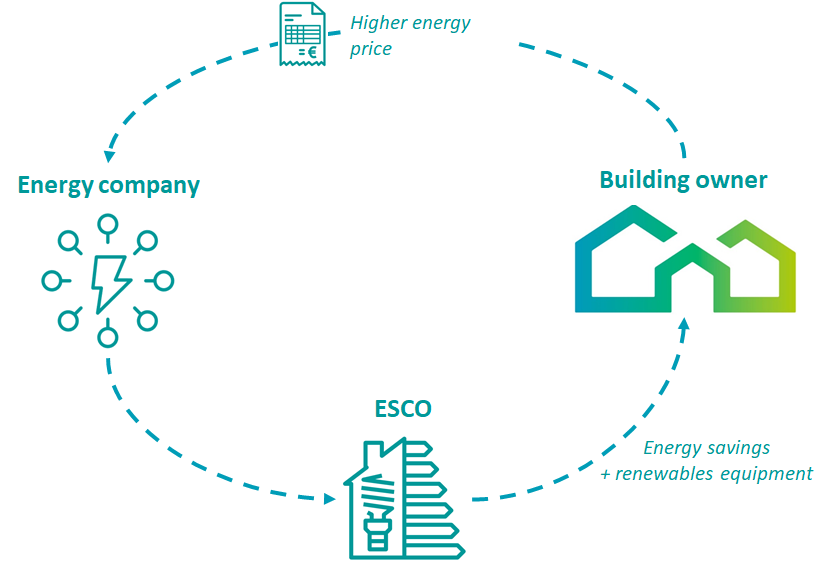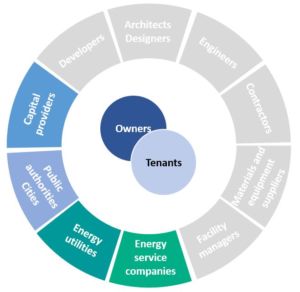Energy Savings Obligations
Description
Energy Saving Obligations are a policy tool obliging energy companies to implement and realise energy savings at the level of end users. It stimulates business models with financial incentives offered by energy suppliers to building owners, renters or energy service companies.
 Innovative financing options can also emerge under energy saving obligations for utilities. The utility (potentially via an Energy service company or ESCO) proposes incentives for energy efficiency investments, financed through higher energy prices. These incentives offer opportunities for building owners. Despite first intention oriented to energy savings and energy efficiency, energy saving obligations could also be an important driver for renewable energy technology in the built environment.
Innovative financing options can also emerge under energy saving obligations for utilities. The utility (potentially via an Energy service company or ESCO) proposes incentives for energy efficiency investments, financed through higher energy prices. These incentives offer opportunities for building owners. Despite first intention oriented to energy savings and energy efficiency, energy saving obligations could also be an important driver for renewable energy technology in the built environment.
Energy Saving Obligations stimulate energy companies to develop new energy efficiency services for final customers (often in partnership with electricians and installers), or they outsource the obligation and delegate it to the ESCO. Generally, in this business model, energy companies transfer the costs of the energy efficiency measures (and potentially renewables) to final consumers, through higher energy prices.
Energy companies, or ESCO partners, need to create financial incentives for consumers to voluntarily implement energy savings in buildings. For instance, in Italy, France or UK, subsidies for saving measures are the most common financial incentive. In order to be able to finance the incentives offered, energy companies are generally allowed to charge higher energy prices to all customers. In many cases, financial incentives for energy consumers are combined with information to encourage energy efficiency measures.
"What” (value proposition)
For governments:
- Energy Saving Obligations are a tool to catalyse energy savings without having to use government funds to finance and administer the programme. Instead, costs are paid through higher electricity prices;
- Energy Saving Obligations force energy suppliers to take actions;
- Energy companies are generally in a strong position to implement the obligations as they already have direct contacts to households and (usually) a strong financial position.
For building owners:
- Energy Saving Obligations reduce the barrier of high up-front costs (CAPEX) and cost effectiveness of energy efficiency measures (or renewables) for the building owner, as energy companies provide financial incentives;
- The building owner is usually supported by energy companies with information and advice, and organisation of the installation.
For ESCOs:
- Energy Saving Obligations may create demand for energy efficiency services.
"Who” (target customer)
Energy savings obligations can be applied to all types of buildings.
"How” (value chain, activities, resources)
Directly involved actors are energy companies, usually energy suppliers or distributors on whom the obligation is imposed
- In the British and French schemes, the obliged parties are energy suppliers;
- In Denmark, Flanders and Italy the obliged parties are network companies. Frequently, the utilities enter into partnerships with service providers such as ESCOs or installers;
- In the UK, energy suppliers offer energy services themselves, or hire external companies;
- In Italy and Denmark, obliged energy companies are not allowed to implement energy saving projects themselves. The measures are implemented at the clients of the energy companies, or the end user sectors. Government is involved in setting the regulatory framework.
Most existing schemes focus on energy efficiency measures. However, Energy Saving Obligations could be extended to cover renewables. For instance, in France, most savings are realized by installing efficient condensing boilers. A little more than 10% of the certificates were generated through the installation of heat pumps.
"Why” (revenue model and cost structure)
Cost structure:
For government, costs are only related to the approval of requests and general support services.
Revenues structure:
For government: costs are paid through higher electricity prices.
For ESCOs: Energy companies implement new energy efficiency measures, covering costs associated to the installation of the new measures. Companies can pass on the costs of the energy efficiency measures (and renewables) to all consumers via higher energy prices.





